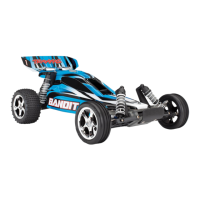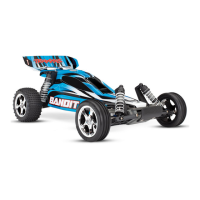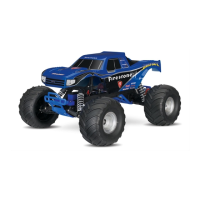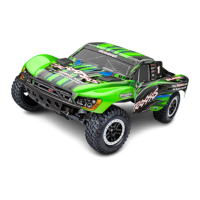Do you have a question about the Traxxas Bandit 2405 and is the answer not in the manual?
Contact Traxxas for assistance with your model and available support options.
Outlines procedures to get your model operational quickly for immediate use.
Provides contact information for technical support and service inquiries.
Explains icons used for warnings, helpful hints, and cross-references throughout the manual.
Highlights critical safety rules, including avoiding public roads and crowds, and handling hot components.
Lists the specialty metric tools included with your Traxxas model.
Suggests additional items beneficial for operating and maintaining your R/C model.
Instructions on how to apply self-adhesive decals to enhance your model's appearance.
Guidance on using pre-applied tape to secure the wing to the Rustler body.
Steps for installing a replacement wing on the Bandit model.
Recommends peak-detecting chargers for optimal battery performance and longevity.
Defines key terms and components used within the Traxxas radio system.
Step-by-step guide for inserting 8 AA batteries into the TQ transmitter.
Procedure for placing and securing the battery pack within the model's compartment.
Information on using alkaline or rechargeable batteries in the transmitter.
Instructions for installing the antenna mast and wire for optimal radio reception.
Details the functions of the steering wheel, throttle trigger, and trim controls.
Explains throttle neutral adjustment and servo reversing switch functions.
Essential rules for safe operation, including frequency clearing and transmitter power sequencing.
Procedures to check radio system adjustments before operating the model.
Steps to ensure proper radio system function and range before each use.
Ensures proper transmitter settings before programming the XL-5 ESC.
Step-by-step guide to calibrate the ESC with the transmitter.
Details how to operate the speed control and test programming.
Explains the ESC's automatic shutdown feature to prevent overheating.
Information on selecting different operating profiles for the speed control.
Describes Sport, Race, and Training modes with their respective forward/brake/reverse settings.
Instructions to set the ESC to 100% forward, 100% brakes, 100% reverse.
Instructions to set the ESC to 100% forward, 100% brakes, no reverse.
Instructions to set the ESC to 50% forward, 100% brakes, 50% reverse.
Critical warnings regarding water exposure, heat, and proper component handling.
Factors affecting run time, including battery capacity (mAh) and driving style.
Recommendations for increasing battery life and motor performance.
Procedure for setting the slipper clutch to prevent tire spin and protect the drivetrain.
Guidance on setting wheel alignment for improved handling and stability.
Information on adjusting shocks, including oil viscosity, pistons, and ride height.
Discussion on how aftermarket wheels and tires affect model geometry and performance.
Overview of stock versus modified motors and their impact on power and run time.
Provides a range of gear combinations for different models and motor types.
Steps to re-center the steering servo and properly install the servo horn.
Check for cracked parts, binding, loose connections, and general wear.
Covers maintenance for slipper clutch, chassis, steering, motor, and shocks.
Guidance on cleaning and preparing the model for storage, including battery removal.
Diagnoses issues like no power, blinking lights, and lack of response.
Addresses causes for reduced radio range and interference.
Troubleshoots thermal shutdown, ESC connection, or battery/motor issues.
Checks wiring, radio components, and battery connections.
Correcting motor wiring if it runs in the reverse direction.
Resolves problems preventing the ESC from entering programming mode.
Diagnoses issues related to capacitors, proximity, connections, or motor wear.
Identifies causes for slow performance, such as ESC profile or battery condition.
Checks throttle trim and ESC profile settings for reverse functionality.
Indicates potential internal damage requiring service.
Addresses issues related to gear mesh and slipper clutch adjustment.
| Brand | Traxxas |
|---|---|
| Model | Bandit 2405 |
| Category | Motorized Toy Car |
| Language | English |











